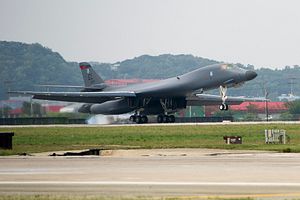On September 21, in a show of resolve to underline the United States’ defense commitment to the Republic of Korea (ROK), a United States Air Force (USAF) B-1B Lancer strategic bomber performed a low-level flight near the demilitarized zone (DMZ), the closest a B-1B bomber has ever flown to the border of North Korea, according to a USAF press release.
The B-1B took off from Anderson Air Base, Guam and, after completing its deterrence aerial patrol near the DMZ, landed at Osan Air Base, in Pyeongtaek, 70 kilometers south of Seoul. This is the first time in 20 years that a B-1B Lancer has landed on the Korean peninsula and it is unclear when the aircraft is scheduled to return to Guam.
“The bond between the United States and the Republic of Korea is ironclad and the strength of that commitment will not be shaken by North Korea’s aggressive behavior,” said Lieutenant General Thomas W. Bergeson, the commander of the 7th Air Force on September 21. “What we are showing today is just one tool we have to choose from a wide array of options. The alliance grows stronger every day and we remain prepared to defend and to preserve the security of the Korean Peninsula and the region.”
The bomber deployment follows North Korea’s fifth-ever nuclear test and comes only nine days after the United States sent two B-1B Lancer heavy strategic bombers, escorted by USAF F-16 fighter jets and ROK Air Force F-15K warplanes, on a similar patrol over the Korean peninsula. As I explained previously:
In what can be considered the United States’ stock response to Pyongyang’s saber rattling, the USAF dispatched a B-52H, accompanied on its flight by two ROK F-15Ks and two USAF F-16s, to the Korean peninsula in January to conduct a deterrence patrol in response to a recent North Korean nuclear test. (The Diplomat’s Van Jackson wrote a short piece critiquing U.S. bomber overflights and the failure of U.S. nuclear signaling vis-a-vis North Korea.)
A USAF B-2 Spirit nuclear-capable stealth bomber entered North Korean airspace in 2013. Three B-2 stealth bombers are currently stationed on Guam to participate in a number of training exercises with regional allies.
The B-1B is the backbone of the USAF’s bomber fleet and can deliver the largest payload of both guided and unguided weapons in the USAF’s inventory, as I noted elsewhere:
The USAF’s 62 B-1B Lancers are capable of carrying up to 75,000 pounds (34,000 kilograms) of weapons—the largest payload of both guided and unguided weapons in the USAF’s inventory. Though heavily armed, the bomber can reach a top speed of Mach 1.2 and can operate at altitudes above 30,000 feet (9,100 meters). The B-1B bombers will be permanently stationed on Guam as part of U.S. Pacific Command’s so-called Continuous Bomber Presence.
“The Korean Peninsula Faces a grave security crisis as a result of North Korea’s 5th nuclear experiment along with its continued launching of SLBM and ballistic missiles despite the concerns of the International community,” said Lieutenant General Lee Wang-Kuen, the ROK Air Force’s Operational Commander on September 21. As The Diplomat reported earlier in the week, North Korea claims that it has successfully tested a new rocket engine, a potential milestone in Pyongyang’s burgeoning missile program.
































